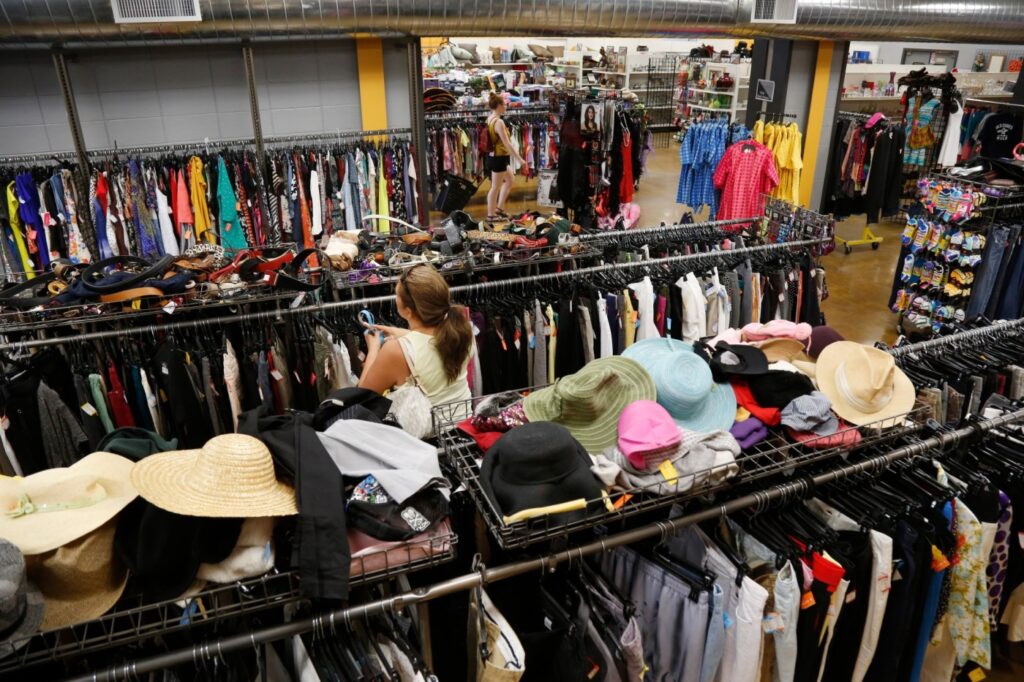
In California, it’s relatively easy to recycle aluminum cans, newspapers or glass bottles. But for one of the most commonly used household products — clothes — options are few.
Every year, tons of unwanted shirts, jeans, dresses, jackets and other garments end up in landfills across the state. Almost none are recycled. Some are donated to thrift stores, but thrift stores often re-sell to companies that ship them to developing nations, such as Ghana and Chile, where they are piled in mountains as high as 50 feet in deserts and along rivers.
On Friday, state lawmakers sent a bill to Gov. Gavin Newsom’s desk that would require companies to set up the nation’s first mandatory take-back program for unwanted clothes.
If Newsom signs the bill, SB 707, as expected, companies that make clothing and other textiles sold in California, including drapes, sheets and towels, will be required to create a non-profit organization by 2026 that would set up hundreds of collection sites at thrift stores, begin mail-back programs and take other steps in all of California’s 58 counties to take back and recycle their products by 2030.
“All across America, there are closets full of clothing that never gets worn,” said Mark Murray, executive director of Californians Against Waste, an environmental group based in Sacramento that supports the bill. “It is surrounding us. Look around your house. It’s the biggest waste problem that we’re ignoring.”
The accumulation of clothing waste is being made worse by “fast fashion,” a trend in which clothing companies make low-cost clothes intended to be worn only a few times as fashions shift.
“We have no use for things that aren’t in fashion, or don’t fit, or are worn out, and they often have no place left to go but the landfill,” Murray said.
The numbers are daunting.
In 2021, roughly 1.2 million tons of clothes and textiles were disposed of in California, according to the California Department of Resources Recycling and Recovery, known as CalRecycle. While 95% of them are reusable or recyclable, only 15% currently are.
The bill is the latest in a trend of California lawmakers requiring companies that make difficult-to-dispose-of products to take responsibility for recycling and reusing them, rather than leaving the cost and challenge up to local city and county governments.
One example: Under state law since 2018, consumers are charged $10.50 when they buy a new mattress in California. That money helps fund an industry-led program, the Mattress Recycling Council, that has opened 240 collection sites and now recycles 85% of old mattresses in the state.
Similar “extended producer responsibility” programs with paint and carpet have been put in place in recent years. Newsom signed a landmark law in 2022 that will require the packaging industry to take back plastic packaging in the next few years.
The idea is to shift the burden away from consumers and government — which have to pay to expand and build landfills — to industry, which profits from selling the products in the first place, said State Sen. Josh Newman, a Fullerton Democrat, who wrote the clothing recycling bill.
“If I produce something as a manufacturer, I have a responsibility to participate in the full life cycle of that product, with the goal of minimizing the impact on the environment,” Newman said.
Lawyer Paulin Silva shows clothes dumped in the desert, in La Pampa sector of Alto Hospicio, about 10 km east of the city of Iquique, Chile, on November 11, 2022. – Hills of clothes from the United States, Asia and Europe; used cars from Japan or Korea and thousands of tires contaminate extensive areas of the immense but vulnerable Atacama desert in northern Chile, which has become the planet’s “backyard”. (Photo by MARTIN BERNETTI/AFP via Getty Images)
France, center of the world’s fashion industry, already has a mandatory clothing recycling program. Other states around the U.S. are watching California to see if this one will work.
Industry groups at first opposed the bill, led by the California Chamber of Commerce and the American Apparel and Footwear Association, which represents more than 300 large clothing companies. After negotiating some changes with Newman, including allowing the industry group to do an assessment and work with CalRecycle to set recycling targets, they shifted to neutral.
“The biggest challenge is that apparel brands are not waste-management providers,” said Chelsea Murtha, the association’s senior director of sustainability. “This isn’t their area of expertise. Building out a system that doesn’t exist in a state this big is going to be a challenge. It’s ambitious. We are hopeful we can rise to the challenge.”
Murtha said the nonprofit group the industry is required to set up will likely operate in or alongside thrift stores in big counties and set up collection bins in rural counties. The costs will be passed on to consumers in the price of the clothing, she said, adding that it’s too early to provide an estimate.
Newman said he expected the law will only add “pennies” to the cost of new clothing.
Murtha said clothes in good condition will probably be resold or recycled. Damaged or worn garments can be recycled fairly easily if they are made of wool, cotton or other natural fibers. The fibers can be reused and spun into new fabrics.
Some old clothes will be shredded and used to stuff pillows or provide insulation for other products, she said. Garments made of mixed fabrics, such as polyester and spandex, can be broken down by a chemical process in which the basic materials are recycled.
The industry has not been pleased to see many old clothes ending up in landfills or waste piles in African and South America, Murtha added.
“That’s not something that any designer or sustainability team at an apparel brand wants,” she said.
